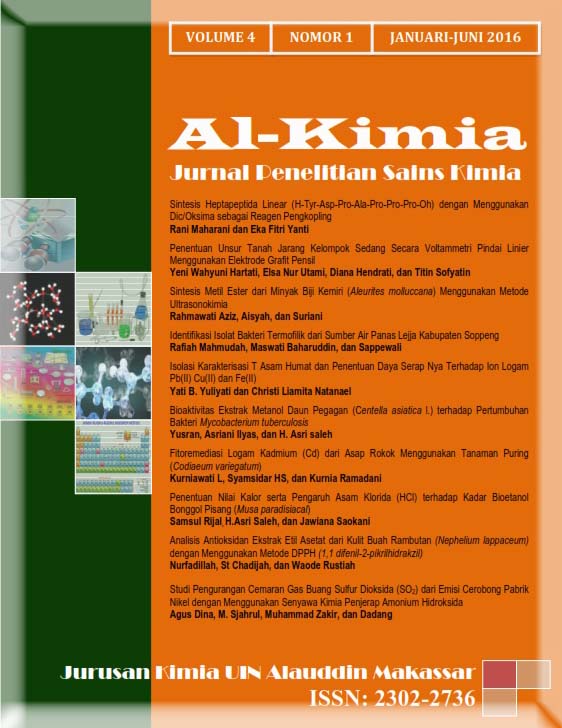Analisis Antioksidan Ekstrak Etil Asetat Dari Kulit Buah Rambutan (Nephelium Lappaceum) dengan Menggunakan Metode dpph (1,1 difenil-2-pikrilhidrakzil)
Abstract
Rapiah rambutan fruit leather (Nephelium lappaceum) is one of the traditional medicine to cure various diseases such as fever and dysentery. Scientific research previously stated rambutan fruit peel skin Rapiah rambutan (Nephelium lappaceum) potentially have antioxidant content. Through this research can know the effect of solvent ethyl acetate to extract optimal rambutan fruit skin in antioxidants withdrawal. The method used for extraction is macerated using methanol and partitioned with liquid-liquid extraction using ethyl acetate solvent with a ratio (1:3), (1:4) and (1:5) which produces a thick rind extract rambutan. The extract was tested color and separated by thin layer chromatography (TLC) using the eluent butanol: glacial acetic acid: water (BAA) (4: 1: 5). Antioxidants are determined by testing against DPPH free radicals by measuring the absorbance of DPPH (1,1-diphenyl-2-pikrilhidraksil) at a wavelength of 517 nm. So that the results of this study showed the highest % reduction obtained at a ratio (1:3).
Downloads
References
Dewi Kusuma Arifia, Lestari Umie, dan Lestari Sri Rahayu, “Efek Ekstraksi Kulit Buah Rambutan Terhadap Peroksida Lipid Hepar Tikus Obesitas”, Universitas Negeri Malang (Maret, 2012), vol 1. No. 1 (17 Januari 2014).
Dwi SriRahayu, Dra. Dewi Kusrini M.Si dan Dra.Enny Fachriyah M.Si, “Penentuan Aktivitas Antioksidan dari Ekstrak Etanol Daun Ketapang (Terminali acatappa L) denganMetode 1,1-Difenil-2-Pikrilhidrazil (DPPH),” Labortorium Kimia Organik, Jurusan Kimia FMIPA UniversitasDiponegoro, (13 Januari 2014)
.
Hartanto Hondy, “Identifikasi Potensi Antioksidan Minuman Cokelat Dari Kakao Lindak Dengan Berbagaicara Preparasi: Metode Radikal Bebas DPPH”. Skripsi (Universitas Katolik Widya Mandala Surabaya, 2012) (08 Agustus 2014).
Hayati, KamilahElok, “Fraksinasi dan Identifikasi Senyawa Tanin Pada daun Belimbing Wuluh”, Universitas Islam Negeri Maulana malik Ibrahim: Malang, 2010 (08 Agustus 2014).
Haryoto, Santoro Brotodan Nugroho Hafid,”Aktivitas Antioksidan fraksi Polar Metanol dari Kulit Kayu Batang Shoreaacum inatissima dengan metode DPPH”, Universitas Muhammadiyah Surakarta, vol. 8 no. 1 (juli 2007) (15 Januari 2014).
Hertiani Triana, “Daya Antioksidan Ekstrak Etanol Rimpang Temu Kunci Dengan Metode DPPH”, Universitas Gadja Mada: Yogyakarta, 2013 (08 Agustus2014).
Maulida Dewi dan Zulkarnaen Naufal,”Ekstraksi Antioksidan (Likopen) Dari Buah Tomat Dengan Menggunakan Solven Campuran, n-Heksan, asetondan Etanol”.Skripsi, Universitas diponegoro (Mei 2010) (10 Agustus 2014).
Saleh Purnawati Lisa, Suryanto Edi danYudistiraadithya, “AktivitasAntioksidan Dari ekstrakTongkolJagung (Zea Mays L.)”, FMIPA UNSRAT Manado, vol. 2 no.1 (Juli 2012) (20 Januari 20s14).
Authors who publish with this journal agree to the following terms:
1) Authors retain copyright and grant the journal right of first publication with the work simultaneously licensed under a Creative Commons Attribution License that allows others to share the work with an acknowledgement of the work's authorship and initial publication in this journal.
2) Authors are able to enter into separate, additional contractual arrangements for the non-exclusive distribution of the journal's published version of the work (e.g., post it to an institutional repository or publish it in a book), with an acknowledgement of its initial publication in this journal.
3)Authors are permitted and encouraged to post their work online (e.g., in institutional repositories or on their website) prior to and during the submission process, as it can lead to productive exchanges, as well as earlier and greater citation of published work (See The Effect of Open Access).


